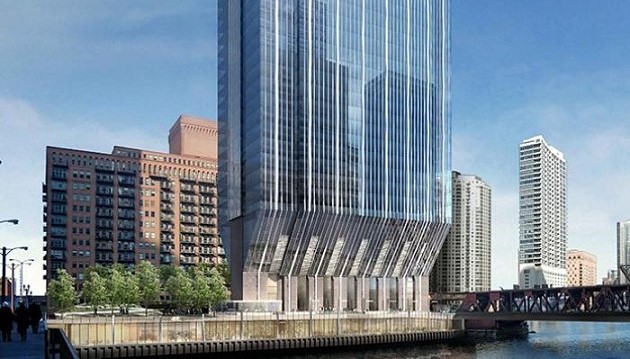 CHICAGO— The 2016 Chicago office market continued to improve in the second quarter, and the CBD's direct vacancy rate sank 32 bps from 11.97% at the end of the first quarter to 11.65%, its lowest point since 2008, according to a market overview just published by MBRE . Perhaps the most important events in the quarter were that developers broke ground on another two office towers in the West Loop, bringing the total amount of new space under construction or announced to roughly 4.4 million square feet. But with a sizable amount of this new space already pre-leased, the prospects to absorb the rest without a big boost in the vacancy rate appear good. And that may encourage builders to launch other projects in the CBD. “ Developers and construction lenders much prefer to have significant leasing in place prior to commencing work,” Mark Buth , executive vice president, managing director with MBRE, tells GlobeSt.com. “However, based the success of the projects underway, certain developers will weigh the risk of going spec against the reward of having product under way in position to capture tenancy looking for new construction in the 2018-2020 timeframe.” A lot “depends on the risk tolerance of the equity behind the deal,” he adds. “Most likely it would be another smaller, under 500,000 square foot, development that is very confident in its product, location and timing and positive feedback from the marketplace.” The CBD saw 570,485 square feet of total absorption in the second quarter, increasing the absorption for 2016 to 918,854 square feet, MBRE found. “Positive absorption was seen in all submarkets,” according to the report. North Michigan Ave. led the way with 144,561 square feet of absorption, largely due to ACGME moving into 88,696 square feet at 401 N. Michigan Ave. The class A vacancy had hit 16.04% by the end of 2010, but after dropping 23 bps in the second quarter of 2016, it now stands at 10.6%, and just 6.9% in River North. And although Class B properties still have the highest vacancy rate at 13.15%, it did decrease by 35 bps in the second quarter. Class C properties reached a historic low vacancy rate of 11.16%, primarily because landlords have converted many properties to class B or non-office use, MBRE found. “Continuing suburban migration and the expansion of existing companies should enable the market to absorb the 1.9 million square feet of additional inventory that is scheduled to be completed in 2018,” the researchers conclude. “The developers' ability to attract tenants to the 443,645 square foot office building under construction at 625 W. Adams, which is being built on speculation, will be an important market indicator.”
CHICAGO— The 2016 Chicago office market continued to improve in the second quarter, and the CBD's direct vacancy rate sank 32 bps from 11.97% at the end of the first quarter to 11.65%, its lowest point since 2008, according to a market overview just published by MBRE . Perhaps the most important events in the quarter were that developers broke ground on another two office towers in the West Loop, bringing the total amount of new space under construction or announced to roughly 4.4 million square feet. But with a sizable amount of this new space already pre-leased, the prospects to absorb the rest without a big boost in the vacancy rate appear good. And that may encourage builders to launch other projects in the CBD. “ Developers and construction lenders much prefer to have significant leasing in place prior to commencing work,” Mark Buth , executive vice president, managing director with MBRE, tells GlobeSt.com. “However, based the success of the projects underway, certain developers will weigh the risk of going spec against the reward of having product under way in position to capture tenancy looking for new construction in the 2018-2020 timeframe.” A lot “depends on the risk tolerance of the equity behind the deal,” he adds. “Most likely it would be another smaller, under 500,000 square foot, development that is very confident in its product, location and timing and positive feedback from the marketplace.” The CBD saw 570,485 square feet of total absorption in the second quarter, increasing the absorption for 2016 to 918,854 square feet, MBRE found. “Positive absorption was seen in all submarkets,” according to the report. North Michigan Ave. led the way with 144,561 square feet of absorption, largely due to ACGME moving into 88,696 square feet at 401 N. Michigan Ave. The class A vacancy had hit 16.04% by the end of 2010, but after dropping 23 bps in the second quarter of 2016, it now stands at 10.6%, and just 6.9% in River North. And although Class B properties still have the highest vacancy rate at 13.15%, it did decrease by 35 bps in the second quarter. Class C properties reached a historic low vacancy rate of 11.16%, primarily because landlords have converted many properties to class B or non-office use, MBRE found. “Continuing suburban migration and the expansion of existing companies should enable the market to absorb the 1.9 million square feet of additional inventory that is scheduled to be completed in 2018,” the researchers conclude. “The developers' ability to attract tenants to the 443,645 square foot office building under construction at 625 W. Adams, which is being built on speculation, will be an important market indicator.”  CHICAGO— The 2016 Chicago office market continued to improve in the second quarter, and the CBD's direct vacancy rate sank 32 bps from 11.97% at the end of the first quarter to 11.65%, its lowest point since 2008, according to a market overview just published by MBRE . Perhaps the most important events in the quarter were that developers broke ground on another two office towers in the West Loop, bringing the total amount of new space under construction or announced to roughly 4.4 million square feet. But with a sizable amount of this new space already pre-leased, the prospects to absorb the rest without a big boost in the vacancy rate appear good. And that may encourage builders to launch other projects in the CBD. “ Developers and construction lenders much prefer to have significant leasing in place prior to commencing work,” Mark Buth , executive vice president, managing director with MBRE, tells GlobeSt.com. “However, based the success of the projects underway, certain developers will weigh the risk of going spec against the reward of having product under way in position to capture tenancy looking for new construction in the 2018-2020 timeframe.” A lot “depends on the risk tolerance of the equity behind the deal,” he adds. “Most likely it would be another smaller, under 500,000 square foot, development that is very confident in its product, location and timing and positive feedback from the marketplace.” The CBD saw 570,485 square feet of total absorption in the second quarter, increasing the absorption for 2016 to 918,854 square feet, MBRE found. “Positive absorption was seen in all submarkets,” according to the report. North Michigan Ave. led the way with 144,561 square feet of absorption, largely due to ACGME moving into 88,696 square feet at 401 N. Michigan Ave. The class A vacancy had hit 16.04% by the end of 2010, but after dropping 23 bps in the second quarter of 2016, it now stands at 10.6%, and just 6.9% in River North. And although Class B properties still have the highest vacancy rate at 13.15%, it did decrease by 35 bps in the second quarter. Class C properties reached a historic low vacancy rate of 11.16%, primarily because landlords have converted many properties to class B or non-office use, MBRE found. “Continuing suburban migration and the expansion of existing companies should enable the market to absorb the 1.9 million square feet of additional inventory that is scheduled to be completed in 2018,” the researchers conclude. “The developers' ability to attract tenants to the 443,645 square foot office building under construction at 625 W. Adams, which is being built on speculation, will be an important market indicator.”
CHICAGO— The 2016 Chicago office market continued to improve in the second quarter, and the CBD's direct vacancy rate sank 32 bps from 11.97% at the end of the first quarter to 11.65%, its lowest point since 2008, according to a market overview just published by MBRE . Perhaps the most important events in the quarter were that developers broke ground on another two office towers in the West Loop, bringing the total amount of new space under construction or announced to roughly 4.4 million square feet. But with a sizable amount of this new space already pre-leased, the prospects to absorb the rest without a big boost in the vacancy rate appear good. And that may encourage builders to launch other projects in the CBD. “ Developers and construction lenders much prefer to have significant leasing in place prior to commencing work,” Mark Buth , executive vice president, managing director with MBRE, tells GlobeSt.com. “However, based the success of the projects underway, certain developers will weigh the risk of going spec against the reward of having product under way in position to capture tenancy looking for new construction in the 2018-2020 timeframe.” A lot “depends on the risk tolerance of the equity behind the deal,” he adds. “Most likely it would be another smaller, under 500,000 square foot, development that is very confident in its product, location and timing and positive feedback from the marketplace.” The CBD saw 570,485 square feet of total absorption in the second quarter, increasing the absorption for 2016 to 918,854 square feet, MBRE found. “Positive absorption was seen in all submarkets,” according to the report. North Michigan Ave. led the way with 144,561 square feet of absorption, largely due to ACGME moving into 88,696 square feet at 401 N. Michigan Ave. The class A vacancy had hit 16.04% by the end of 2010, but after dropping 23 bps in the second quarter of 2016, it now stands at 10.6%, and just 6.9% in River North. And although Class B properties still have the highest vacancy rate at 13.15%, it did decrease by 35 bps in the second quarter. Class C properties reached a historic low vacancy rate of 11.16%, primarily because landlords have converted many properties to class B or non-office use, MBRE found. “Continuing suburban migration and the expansion of existing companies should enable the market to absorb the 1.9 million square feet of additional inventory that is scheduled to be completed in 2018,” the researchers conclude. “The developers' ability to attract tenants to the 443,645 square foot office building under construction at 625 W. Adams, which is being built on speculation, will be an important market indicator.”
Want to continue reading?
Become a Free ALM Digital Reader.
Once you are an ALM Digital Member, you’ll receive:
- Breaking commercial real estate news and analysis, on-site and via our newsletters and custom alerts
- Educational webcasts, white papers, and ebooks from industry thought leaders
- Critical coverage of the property casualty insurance and financial advisory markets on our other ALM sites, PropertyCasualty360 and ThinkAdvisor
Already have an account? Sign In Now
*May exclude premium content© 2024 ALM Global, LLC, All Rights Reserved. Request academic re-use from www.copyright.com. All other uses, submit a request to [email protected]. For more information visit Asset & Logo Licensing.








